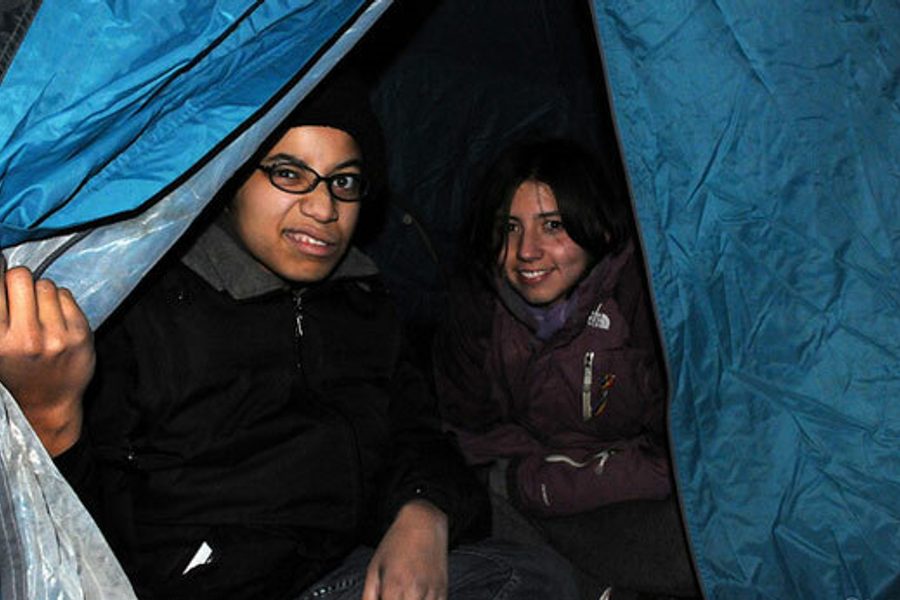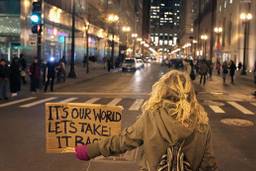
On the night of Sunday, December 4, members of Occupy Chicago finally camped out overnight, and their camp is still standing at the time of writing. They had to go all the way to the border of the Woodlawn and Englewood neighborhoods on the south side to do it.
In the process, they may have helped point out a future direction for the Occupy movement, a direction further cemented by Tuesday’s national day of action to stop and reverse foreclosures, Occupy Our Homes.
I say “a direction” rather than “the direction” for a reason, which is that the last thing the Occupy movement—regional, national or global—needs is another lecture on what its strategy should be from a pundit on the fringes. [Full disclosure: My partner is on the Social Media and Press committees for Occupy Chicago, and I’ve attended marches, General Assemblies and teach-ins]. But when I attended the General Assembly (GA) held at New Beginnings Church on Sunday, it was clear there was a new kind of energy present, with more than one participant describing it was a “watershed moment” for Chicago’s occupiers.
That’s not to say this was a perfect or unproblematic action, either in concept or execution. The Chicago Tribune’s coverage alludes to some of the differences between what Occupy Chicago are about and the mission of Pastor Corey Brooks and his Project Hood, and that was certainly on display at the GA.
In video recorded on Monday, December 5, Pastor Brooks describes both his mission and his reaction to Occupy Chicago’s desire to visit him, saying:
“I was real thankful and grateful and excited when I got a call that they were going to come out and stand in support of what we’re trying to do to stop violence, and us acquiring this building… It’s one thing to go and protest on Wall Street, but it says something else about your commitment when you come to the inner city streets. A lot of people can go and try to stare down bankers who are in suits, but it’s another thing to come to a neighborhood and tell gangbangers ‘we don’t want violence anymore.’ I find it really compassionate and gracious for them to be concerned not just about Wall Street and downtown, but what’s going on in the inner city and on these streets.”
New Energy, New Allies, New Challenges
Occupy Chicago was there to stand, or rather camp, in solidarity with Pastor Brooks, who has been camping out on the roof of the Super Motel, directly across King Drive from his church, for almost two weeks. At the GA, participants discussed how to help raise the $450,000 the pastor needs to buy the motel and convert it into a community center.
Many occupiers were clearly excited to be there and enthused by the pastor’s rooftop vigil. “I haven’t seen this kind of energy at a GA in a while,” said one regular participant, and up went the “spirit fingers” of agreement.
As the meeting developed (or devolved) into a series of more general announcements, however, there was some resistance from a New Beginnings member who questioned the lack of involvement of other church members at the GA, and cautioned Occupy Chicago against thinking they could swoop in and “save” the local community. She went so far as to say that it had not been an appropriate decision for the GA to have been held inside the church (although this decision was approved by both Occupy Chicago’s decision-making process at a previous GA, and by Rev. Brooks himself).
This was followed by a comment from one of the church leaders who sought to delineate the church and Rev. Brooks’ priorities from even those annoucements which might be seen as most relevant: The anti-foreclosure actions were not what New Beginnings is about, he said, making the point that people losing their lives is more serious than people losing their homes.
Part of the challenge here is negotiating the different agendas of groups affiliated with Occupy. As I mentioned on Chicago Newsroom last week with regard to labor’s involvement, the Occupy movement is somewhat porous. That has advantages and disadvantages. The relationship between Occupy Chicago, Occupy The Hood Chicago, Occupy The South Side, and then other external but allied groups and campaigns like the Chicago Anti-Eviction Campaign and now New Beginnings Church, can be complicated for even those within the movement to understand, let alone media observers.
For now, this is a tactical alliance that works, and illustrates that not all Occupiers have to agree on every issue with their allies. (I would hope the difference between this and would-be allies on the City Council who voted for Emanuel’s budget is clear, but will happily expand at length if not.) In the long term, differences of opinion cannot be put off indefinitely.
Immediate Needs and Long-Term Change
There is potential here for both parties to learn, though. Occupy, in Chicago and beyond, needs to learn how to become more inclusive—the movement has never been as white and privileged as some in the media have portrayed it, but it still has a long way to go. It also needs to connect the big political and economic picture it understands so well with the day to day problems faced in neighborhoods like Englewood and Woodlawn.
That’s how Occupy can respond to communities who remain unconvinced, as Loren Taylor told the Tribune about Chicago’s African-American communities: “At first, [the] community wasn’t feeling it. They couldn’t see what is the point.”
If, as many people have said about Occupy’s tactics, one of the important things about the movement is the rediscovered emphasis on physically putting one’s body in a space in such a way that it becomes a political act, what better way to do that in a city so segregated that simply traveling to 66th and King Drive, let alone camping outside overnight there, is not something white northsiders are “supposed” to do. Of couse, it’s what they do when they get there that’s the tricky part. “I’m not going to lie,” said a speaker at the GA, “if a diverse or white group of people show up in different communities, you’ll get different responses.”
But by the same token, community activists may benefit from paying attention to Occupy’s focus on the root causes of those day to day problems. It’s understandable why Rev. Brooks would want to cultivate a positive relationship with Mayor Emanuel, who seems to want to do the same. But it should also be understood that calling for an end to violence is a much less contentious political issue when it is not coupled with calling for an end to the unequal economic structures that create the level of poverty and despair that leads to violence. The problem is that the second, more actively politicized and polarizing part is essential to long-term change.
The necessary balance between the macro and micro, between theory and practice, is expressed in a first-hand account of the camp-out by Karen Looney:
The lack of opportunity in our nation, for education, for empowerment, and for mere survival, has pooled into a vast array of issues. Some of those issues, such as the daily possibility of having bullets fired at one on the way to their peaceful place of community, are more immediate than others. While we, not just the Occupy movement but us as responsible citizens, must keep discussing and acting in long-term ways that address the roots of violence in our country, it is also imperative that we prevent it in the interim.
It won’t be easy. This is not the only challenge or conflict, internal or otherwise, that Occupy Chicago has to deal with right now. In addition to the question of how to deal with well-meaning liberal politicians and would-be allies who would like the movement to stay well-behaved and sensible (more on that here), the group is also having to thrash out issues related to housing and physical safety. It is not alone in that among the various Occupy groups across the U.S.
However, watching the tents go up on King Drive, it was impossible to deny the moment’s symbolic power. Here were a group of activists, many of whom had never been to Englewood or Woodlawn, being welcomed into a temporary camp on the south side after being made to feel thoroughly unwelcome by the City when they tried to make such a camp in the scenic gardens of Grant Park.
Two days later, as Occupy Wall Street presented formerly foreclosed homes to evicted families in Brooklyn (see Allison Kilkenny’s report at Uprising), one of the most striking visuals was the sight of a tent erected on top of one of those houses. It reminded me of nothing so much as the Rev. Brooks’ tent on top of the motel at 66th St. and King Drive.
These actions to connect with communities in the country’s hardest hit neighborhoods must, of course, go beyond the symbolic. But the Occupy movement has, so far, had an excellent grasp of the power symbolic acts can have. This is yet another example.
Joe Macaré is a writer, editor and development and communications professional, originally hailing from the UK and now residing in Chicago. His writing has appeared at In These Times, TruthOut, AlterNet, Dazed and Confused, The Times, Plan B and Stylus. He has appeared on WBEZ radio and Chicago Newsroom to discuss his extensive coverage of the Occupy Chicago movement.


